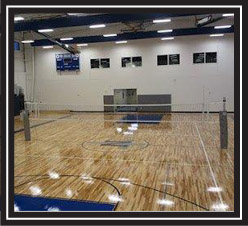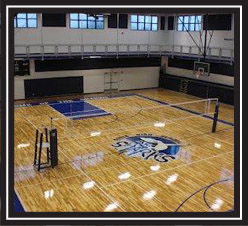
888-822-5638
QUALITY PRODUCTS...OUTSTANDING SERVICE
ATHLETIC RESOURCES
HIGH PERFORMANCE ATHLETIC FLOORING & GYMNASIUM EQUIPMENT
What flooring system is best for my facility?
Floating: Floating systems rest freely without anchorage to a concrete substrate. Different designs of pad and subfloor combinations provide varying levels of shock absorption. In addition, the subfloor components and resilient pads strongly influence the floors performance characteristics. AacerFlex and ScissorLoc are available in DIN Certified versions, which meet the highest performance characteristics for an athletic floor.
Fixed: Fixed floor systems are mechanically fastened to the concrete substrate using a drill and pin system or pneumatic pressure. As a result, fixed floor systems provide an extremely stable subfloor system. In addition, fixed floors offer outstanding buckle resistance to moisture. However, they provide minimal resilience and shock absorption to the athlete.
Fixed Resilient: Fixed resilient floor systems incorporate features of both floating and fixed systems. As a result, they provide stability benefits of anchored subfloors and resiliency benefits of floating systems. Many of our fixed resilient floor systems are DIN Certified.
Do I need to use MFMA certified wood?
The Maple Flooring Manufactures Association was founded in 1897 and they are the authoritative source of technical and general information about maple flooring and related sports flooring systems. Each MFMA mill is subject to regular, unannounced third-party inspections to assure strict adherence to MFMA rules governing continuity of species, millage, and grading. In addition, all MFMA certified maple is grown in forests north of the 35th parallel. The harsher winters and shorter growing seasons yield densely grained maple with fewer imperfections.
Using MFMA northern hard maple for your gymnasium provides peace of mind and quality assurance. Each piece of maple that we provide is embossed on the back with Aacer’s member mill number, guaranteeing that the material has met the strict production standards of the MFMA. Year after year and installation after installation, architects, contractors, school officials, and maintenance personnel insist on using MFMA certified maple for their facilities.
What grade of MFMA certified wood is right for my facility?
When selecting a certain grade of maple, you need to consider your budget and the aesthetic appearance of the floor. Maple flooring is categorized into 1st Grade, 2nd Grade & Better, and 3rd Grade by selecting pieces according to specific characteristics. These characteristics ensure consistency and uniformity within each grade. While every grade of Aacer flooring is guaranteed for durability, each provides its own unique look for your floor.
1st Grade: This is the highest grade available in maple, providing exceptionally clear boards and exemplary maple color.
2nd Grade & Better: Combines premium 1st Grade qualities with tight knots and slight variations in color. 2nd & Better is a richly colored floor.
3rd Grade: Provides all the durability of northern hardwood maple and all the natural variations of the species.
What are the maintenance requirements of a wood floor?
Wood flooring should be swept daily with a treated dust mop to keep the surface free of dust, grit, sand, and abrasive particles. All spillage should be immediately wiped from the floor. Marks can be removed from the floor using an approved cleaner. Wood flooring is typically screened and refinished on an annual basis. Please click the link below to view Aacer Sports Flooring’s maintenance guidelines.
What is the cost comparison of a wood sports floor - vs - a synthetic sports floor?
When comparing the cost of a maple wood floor and a synthetic floor, two critical factors to analyze are life cycle costs and annual maintenance costs. Maple wood flooring possesses a life expectancy of 40 years. Most synthetic floors have a life expectancy of 15 years. A maple wood floor will last nearly three times as long as a synthetic floor.
Wood and synthetic floors will have similar daily maintenance costs. All manufactures recommend that the floor be swept on a daily basis with a treated dust mop to remove dust, grit, sand, and abrasive particles. The weekly maintenance costs will be higher for synthetic flooring. All synthetic manufactures recommend that their floor system be cleaned at least once a week with an auto-scrubber and specific cleaning chemicals. An auto-scrubber should never be used on a wood floor. On an annual basis, synthetic flooring should be deep cleaned and maple flooring should be screened and refinished. The cost to screen and refinish maple flooring is typically slightly higher than deep cleaning a synthetic floor.
The MFMA conducted an independent report comparing the life cycle cost of wood flooring, rolled vinyl flooring, and poured urethane flooring. The report concluded that the annual cost for a maple wood floor was $3,140 less than poured urethane and $3,590 less than rolled vinyl.
How much cushion do I need in my sports floor?
To be DIN Certified, a wood sports floor needs a minimum of 53% shock absorption. Please click below to watch Aacer Sports Flooring’s video on shock absorption.
How important is ball bounce in an athletic floor?
To be DIN Certified, a sports floor needs a minimum of 90% ball return. Please click below to watch Aacer Sports Floorings video on ball bounce.
Why choose Aacer sports flooring?
Aacer Sports Flooring is the world leader in sports flooring, design, and manufacturing. They have more than 100 years of experience in every part of the wood flooring industry. ScissorLoc with PowerVent, AacerFlex, and AacerChannel are a few floor systems that set Aacer apart from the competition. ScissorLoc provides a high performance floor with the patented PowerVent system to alleviate moisture concerns. AacerFlex incorporates the Tri Power Pads which provide greater response consistency, lower vibrations, and DIN certified performance. AacerChannel provides a high performance floor with the resiliency and safety of a floating floor system and the stability of an anchored system.



